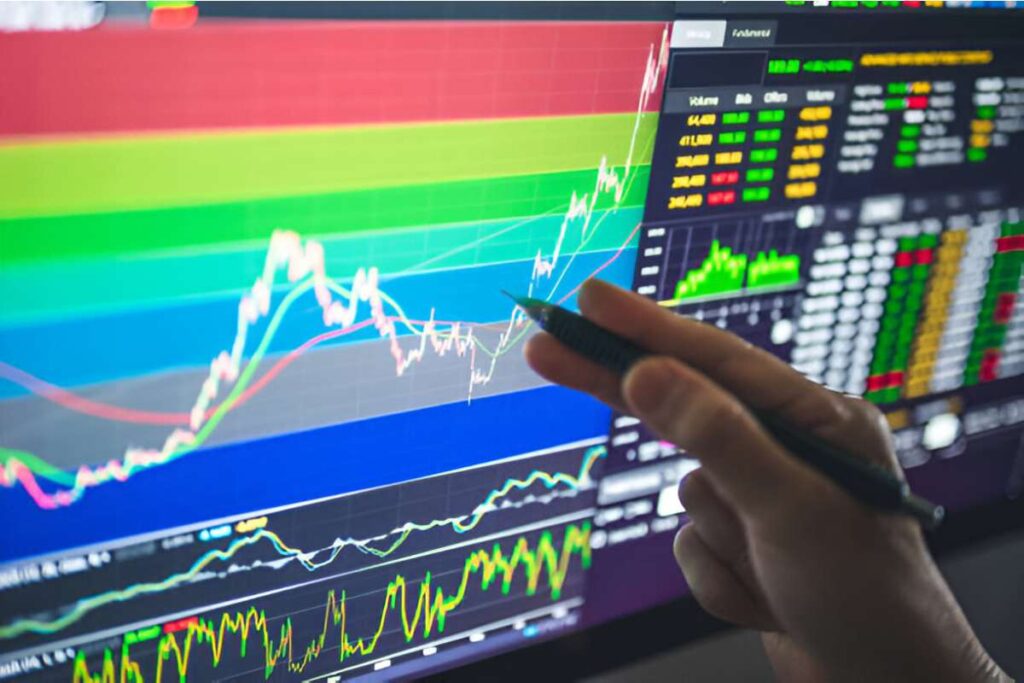Ever wondered why forex trading keeps popping up in your social feeds? Maybe you’re tired of your 9-to-5 and thinking about making money from currency movements. Or perhaps you’re already trading but feel like you’re missing something crucial.
Here’s the reality: forex trading isn’t a get-rich-quick scheme, but it’s also not rocket science. I’ve been in the forex markets for years and seen people make life-changing money – and others lose their shirts. The difference? Understanding what you’re doing.
What is Forex Trading?
Forex trading refers to buying and selling moneys in the foreign exchange market – the world’s largest financial market with over $7.5 trillion traded daily. Think of it as exchanging money when you travel abroad, but on steroids.
In today’s interconnected world, understanding forex trading is critical for anyone wanting to diversify their income, hedge against money risks, or take advantage of global economic movements. Unlike stocks, the forex market never sleeps—it’s open 24/7, giving you flexibility that traditional markets can’t match.
When you’re trading in forex, you’re always trading currency pairs. You’re betting that one currency will strengthen against another. For example, if you buy EUR/USD, you’re betting the Euro will rise against the US Dollar.
Why Forex Trading Matters More in 2025
The global economy is more volatile than ever. Rise, geopolitical tensions, and central bank policies are creating massive currency swings – and forex trading lets you profit from this chaos.
Here’s what’s driving forex opportunities in 2025:
- Central banks are still fighting inflation with interest rate changes
- Geopolitical events are creating currency volatility
- Digital tools and AI are making forex analysis more accessible
- Remote work has given more people time to learn trading
The forex trading landscape has also evolved. Retail traders now have access to institutional-grade tools, and platforms have become incredibly user-friendly. You can start forex trading from your phone during lunch breaks.
Key Benefits of Forex Trading
Let me break down why forex trading has become so attractive:
- 24/5 Market Access – Trade when it fits your schedule, not market hours
- High Liquidity – Enter and exit positions instantly without slippage
- Leverage Opportunities – Control larger positions with smaller capital
- Low Transaction Costs – Spreads are typically lower than stock commissions
- Global Market Exposure – Profit from worldwide economic events
I’ve personally benefited from the flexibility. While my friends are stuck watching stock market hours, I can react to news from Asia at 3 AM or catch the European market opening during my morning coffee.
Forex Trading vs. Stock Trading

Confused between forex trading and stock trading? Here’s the breakdown:
| Feature | Forex Trading | Stock Trading |
| Market Hours | 24/5 continuous | Limited to exchange hours |
| Leverage | Up to 1:500 | Typically 1:2 to 1:4 |
| Market Size | $7.5 trillion daily | $200 billion daily |
| Volatility | High, driven by economic events | Moderate, company-specific |
| Minimum Investment | Can start with $100 | Varies, often higher |
| Profit Potential | Both rising and falling markets | Primarily rising markets |
The biggest difference? Forex trading lets you profit whether currencies go up or down. In stock trading, you typically need stocks to rise (unless you’re short selling, which is more complex).
How to Start Forex Trading for Beginners
Ready to dive into forex trading? Here’s your step-by-step roadmap:
1. Learn the Forex Trading Basics
Before risking real money, understand these forex trading fundamentals:
Currency Pairs:
- Major pairs – EUR/USD, GBP/USD, USD/JPY (most liquid)
- Minor pairs – EUR/GBP, AUD/CAD (less liquid but still tradeable)
- Exotic pairs – USD/TRY, EUR/ZAR (higher spreads, more volatile)
Key Forex Trading Terms:
- Pip – The slightest price movement (usually 0.0001)
- Spread – Difference between buy and sell prices
- Lot – Standard trading unit (100,000 units of base currency)
- Leverage – Borrowed capital to increase position size
2. Choose Your Forex Trading Platform
Your platform can brand or break your forex trading experience. Look for:
Essential Features:
- Regulatory compliance (FCA, CFTC, ASIC)
- Competitive spreads
- Fast execution speeds
- Mobile trading apps
- Educational resources
Popular Forex Trading Platforms:
- MetaTrader 4/5 – Industry standard with advanced charting
- cTrader – Great for algorithmic trading
- TradingView – Excellent for technical analysis
3. Develop Your Forex Trading Strategy
Successful forex trading requires a plan. Here are proven approaches:
Technical Analysis Strategy:
- Use charts and indicators to forecast price actions
- Focus on support/resistance levels, trend lines, and moving averages
- Works well for short-term forex trading
Fundamental Analysis Strategy:
- Trade based on economic news and data
- Monitor central bank decisions, employment reports, and inflation data
- Better for longer-term forex trading positions
Price Action Strategy:
- Read raw price movements without indicators
- Focus on candlestick patterns and market structure
- My personal favourite for forex trading
4. Master Risk Management in Forex Trading
This is where most forex trading beginners fail. Risk management isn’t optional – it’s survival.
Risk Management Rules:
- Never risk more than 2% of your account per trade
- Always use stop-loss orders
- Preserve a risk-to-reward ratio of at least 1:2
- Don’t trade with money you can’t afford to lose
5. Practice with Demo Accounts
Every serious forex trading platform offers demo accounts. Use them! I spent three months on demo before risking real money, which saved me thousands of mistakes.
Demo Account Benefits:
- Learn platform features without risk
- Test your forex trading strategies
- Build confidence before going live
- Understand how news affects currency movements
Advanced Forex Trading Strategies

Once you’ve mastered the basics, these forex trading techniques can boost your profits:
Carry Trading
Profit from interest rate differences between currencies. Borrow low-yielding currencies to buy high-yielding ones. Works best in stable market conditions.
Scalping
You can make dozens of small forex trading profits throughout the day. Forex trading requires intense focus and fast execution, but it can be very profitable for dedicated traders.
Swing Trading
Hold forex trading positions for days or weeks, capturing larger price movements. Perfect for part-time traders who can’t watch charts all day.
News Trading
Trade around major economic announcements. It needs quick reflexes and an understanding of how news impacts currency values.
Case Study: How I Made $5,000 in Forex Trading During Brexit
Let me share a real forex trading example from my own experience. During the Brexit referendum 2016, I saw an opportunity in GBP/USD volatility.
The Setup:
- Market Condition: Extreme uncertainty around Brexit vote
- Currency Pair: GBP/USD
- Strategy: Range trading with tight risk management
- Position Size: 2% risk per trade
The Execution:
I noticed GBP/USD bounced between strong support at 1.4000 and resistance at 1.4600. Instead of trying to predict the referendum outcome, I traded the range.
What I Did Right:
- Stuck to my plan – Didn’t get emotional about Brexit news
- Managed risk – Used 50-pip stop losses consistently
- Took profits – Closed positions at predetermined levels
- Stayed disciplined – Didn’t overtrade during high volatility
The Result:
Over two weeks of forex trading around Brexit uncertainty, I made $5,000 from a $10,000 account. The key wasn’t predicting Brexit—it was systematically trading the volatility.
Lesson Learned:
Successful forex trading isn’t about being right about significant events. It’s about managing risk and staying consistent with your strategy.
Essential Forex Trading Tools and Resources
Here are the tools that make forex trading more effective:
For Market Analysis:
- TradingView – Best charting platform with social features
- Forex Factory – Economic calendar and news
- Krea AI – Generate trading journal templates and analysis reports
Trade Execution For:
- MetaTrader 4/5 – Most general forex trading platforms
- cTrader – Advanced order types and algorithmic trading
- NinjaTrader – Professional-grade analysis tools
Education For:
- BabyPips – Free forex trading education
- Investopedia – Comprehensive financial education
- YouTube channels – Real-time forex trading analysis
Risk Management For:
- Position size calculators – Determine proper trade sizes
- Economic calendars – Track high-impact news events
- Correlation matrices – Understand currency relationships
Common Forex Trading Mistakes to Avoid
I’ve made these mistakes and watched others make them too. Learn from our pain:
Overleverage – Using too much leverage amplifies losses. Start conservative.
No trading plan – Forex trading without a plan is gambling. Write down your strategy.
Emotional trading – Fear and greed kill accounts. Stick to your rules.
Ignoring fundamentals – Technical analysis is excellent, but economic news moves markets.
Poor risk management – One bad trade shouldn’t wipe out weeks of profits.
Overtrading – Quality over quantity. Wait for good forex trading setups.
Final Thoughts on Forex Trading
Forex trading isn’t a magic money machine, but it’s a legitimate way to build wealth if you approach it seriously. The market rewards preparation, discipline, and patience – not get-rich-quick fantasies.
In 2025, forex trading opportunities are everywhere. Currency volatility from global events, accessible technology, and educational resources make it easier than ever to get started. But remember: the same tools that can make you money can lose it just as quickly.
Start small, learn continuously, and never risk more than you can afford to lose. The forex trading journey is a marathon, not a sprint.
Frequently Asked Questions (FAQs)
Q1: What is forex trading?
A: Forex trading is buying and selling moneys in the foreign exchange market to profit from exchange rate fluctuations between different currency pairs.
Q2: How does forex trading benefit individual traders?
A: Forex trading offers 24/5 market access, high liquidness, leverage opportunities, and the ability to profit from rising and falling currency values.
Q3: What are common forex trading mistakes to avoid?
A: Avoid overleverage, trading without a plan, emotional decision-making, ignoring economic fundamentals, poor risk management, and overtrading.
Q4: How much money do I need to twitch forex trading?
A: You can twitch forex trading with as little as $100, though $1,000-$5,000 provides more flexibility and better risk management options.
Q5: Is forex trading profitable?
A: Forex trading can be profitable, but success requires education, practice, discipline, and risk management. Most traders lose money initially while learning.
Ready to start your forex trading journey? Open a demo account today and begin practising with virtual money. The currency markets are waiting – but they’ll only reward those who come prepared.
Don’t Miss These: Marketing Automation Reviews


